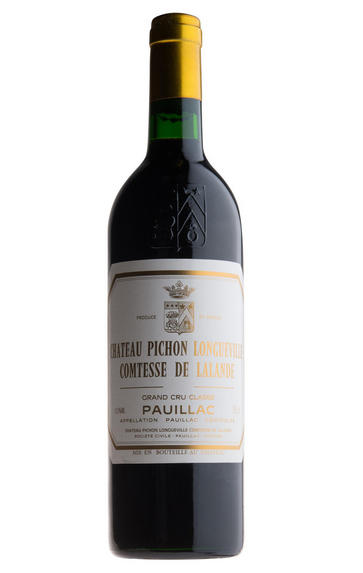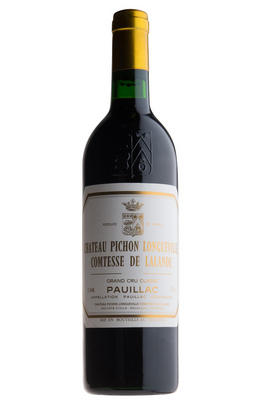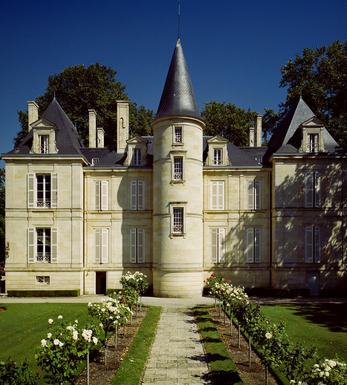
2021 Château Pichon Longueville Comtesse de Lalande, Pauillac, Bordeaux

Critics reviews
The 2021 Pichon-Longueville Comtesse de Lalande needs more coaxing from the glass than previous vintages. Blackberry, juniper and iris flower scents reluctantly unfold, though tasting a second glass, I found the nose more forthcoming. The palate is medium-bodied with fine tannins. The Cabernet is in the driving seat, imparting black fruit, a touch of graphite and chimney soot. Edgy, with a structured and quite serious if slightly short finish. A cerebral proposition for serious Pauillac lovers.
Drink 2026 - 2050
Neal Martin, vinous.com, (May 2022)
Do you want the good news or the bad news first? Let's start with the good. The 2021 Pichon Comtesse is epic and certainly among the great wines of this vintage. Sadly, the coulure and mildew in the first year of organic farming plus dehydration at the end of the growing season took with it fully two thirds of the crop. In other words, there's not much wine to go around. Rich and sumptuous in the glass, yet clocking in at 12.9% alcohol, the 2021 is beautifully layered and totally sensual from the very first taste. Hints of red fruit, flowers, mint, white pepper and dried savory herbs develop with a bit of coaxing. The Cabernet Sauvignon, at 88%, is very high by historical standards. Quite simply, the 2021 is a tour de force from Technical Director Nicolas Glumineau and his team. If there is one wine readers will absolutely jump on en primeur it is Pichon Comtesse. Should the bottled wine turn out as well as this sample, pricing is likely to jump materially because of the tiny production. Don't miss it.
Drink 2031 - 2061
Antonio Galloni, vinous.com (May 2022)
Characteristic elegance but the Pauillac character still evident. Fragrant nose with dark-fruit and floral notes and just a hint of chocolate. Persistent fruit through the mid palate with finely edged tannins. Well structured with good energy and drive, the finish persistent. Balanced and harmonious.
Drink 2028 - 2042
James Lawther, jancisrobinson.com (May 2022)
This estate is one of the most dynamic in contemporary Bordeaux, so it's no surprise that the 2021 Pichon Longueville Comtesse de Lalande is a terrific wine—though its a very atypical blend of 88% Cabernet Sauvignon, 10% Cabernet Franc and 2% Merlot, cropped at a derisory 15 hectoliters per hectare, hints at what a challenging year this was in the vineyards. Unwinding in the glass with aromas of wild berries, blackcurrants, iris, licorice, black truffles, cigar wrapper and sweet soil tones, it's medium to full-bodied, layered and textural, with beautifully refined tannins, lively acids and a supple but serious profile. It will see 60% new oak and, in all likelihood, a classical élevage of fully 18 months.
William Kelley, Wine Advocate (Apr 2022)
This is really spicy with peppercorns, cloves and Chinese spices, especially on the finish. Blackcurrants, too. Medium-bodied, firm and polished with a long, intense finish. 88% cabernet sauvignon, 10% cabernet franc and 2% merlot.
James Suckling, jamessuckling.com (May 2022)
About this WINE

Château Pichon Comtesse
Château Pichon Comtesse is an estate in Pauillac on the Left Bank of Bordeaux. The estate was ranked a Second Growth in Bordeaux’s 1855 classification, and belongs to an unofficial group referred to as “Super Seconds”.
It is located in the southern part of the Pauillac appellation, just next to Château Latour and a short distance from the border with St Julien. The attractive château building here is visible from the D2 road as you approach Pauillac from the south, on the opposite side of the street from Château Pichon Baron. The two neighbours were once part of one larger estate, which was divided in two in 1850. From 1978 until the mid-2000s, Pichon Comtesse was managed by Madame May-Eliane de Lencquesaing, one of the most prominent women in Bordeaux history.
Today, the estate belongs to the Rouzaud family, owners of Champagne Louis Roederer. The estate, which currently has 80 hectares of vines, is managed by talented winemaker Nicolas Glumineau. Nicolas and his team also manage Château de Pez, a sibling estate further north in St Estèphe.

Pauillac
Pauillac is the aristocrat of the Médoc boasting boasting 75 percent of the region’s First Growths and with Grand Cru Classés representing 84 percent of Pauillac's production.
For a small town, surrounded by so many familiar and regal names, Pauillac imparts a slightly seedy impression. There are no grand hotels or restaurants – with the honourable exception of the establishments owned by Jean-Michel Cazes – rather a small port and yacht harbour, and a dominant petrochemical plant.
Yet outside the town, , there is arguably the greatest concentration of fabulous vineyards throughout all Bordeaux, including three of the five First Growths. Bordering St Estèphe to the north and St Julien to the south, Pauillac has fine, deep gravel soils with important iron and marl deposits, and a subtle, softly-rolling landscape, cut by a series of small streams running into the Gironde. The vineyards are located on two gravel-rich plateaux, one to the northwest of the town of Pauillac and the other to the south, with the vines reaching a greater depth than anywhere else in the Médoc.
Pauillac's first growths each have their own unique characteristics; Lafite Rothschild, tucked in the northern part of Pauillac on the St Estèphe border, produces Pauillac's most aromatically complex and subtly-flavoured wine. Mouton Rothschild's vineyards lie on a well-drained gravel ridge and - with its high percentage of Cabernet Sauvignon - can produce (in its best years) Pauillac's most decadently rich, fleshy and exotic wine.
Latour, arguably Bordeaux's most consistent First Growth, is located in southern Pauillac next to St Julien. Its soil is gravel-rich with superb drainage, and Latour's vines penetrate as far as five metres into the soil. It produces perhaps the most long-lived wines of the Médoc.
Recommended Châteaux
Ch. Lafite-Rothschild, Ch. Latour, Ch. Mouton-Rothschild, Ch. Pichon-Longueville Baron, Ch. Pichon Longueville Comtesse de Lalande, Ch. Lynch-Bages, Ch. Grand-Puy-Lacoste, Ch, Pontet-Canet, Les Forts de Latour, Ch. Haut-Batailley, Ch. Batailley, Ch. Haut-Bages Libéral.

Cabernet Sauvignon Blend
Cabernet Sauvignon lends itself particularly well in blends with Merlot. This is actually the archetypal Bordeaux blend, though in different proportions in the sub-regions and sometimes topped up with Cabernet Franc, Malbec, and Petit Verdot.
In the Médoc and Graves the percentage of Cabernet Sauvignon in the blend can range from 95% (Mouton-Rothschild) to as low as 40%. It is particularly suited to the dry, warm, free- draining, gravel-rich soils and is responsible for the redolent cassis characteristics as well as the depth of colour, tannic structure and pronounced acidity of Médoc wines. However 100% Cabernet Sauvignon wines can be slightly hollow-tasting in the middle palate and Merlot with its generous, fleshy fruit flavours acts as a perfect foil by filling in this cavity.
In St-Emilion and Pomerol, the blends are Merlot dominated as Cabernet Sauvignon can struggle to ripen there - when it is included, it adds structure and body to the wine. Sassicaia is the most famous Bordeaux blend in Italy and has spawned many imitations, whereby the blend is now firmly established in the New World and particularly in California and Australia.


Buying options
Add to wishlist
Description
Cabernet Sauvignon 88%, Cabernet Franc 10%, Merlot 2%
Nicolas Glumineau’s energetic reshaping of this estate’s reputation included conversion to organic farming; 2021 was the first year. He admits that he should have sprayed more against mildew, which even affected the Cabernet Sauvignon, but he preferred to stay virtuous. The yield is just 15 hl/ha. This is the highest Cabernet Sauvignon proportion since the equally taxing ’13 vintage. Yet this stands as an atypical monument to Cabernet, full of lively notes of earth, liquorice, cocoa and cassis. The wine is dextrous and clean limbed, and a great success pulled from the jaws of adversity. Drink 2027-2042.
Our score: 17/20
Berry Bros. & Rudd, April 2022
wine at a glance
Delivery and quality guarantee